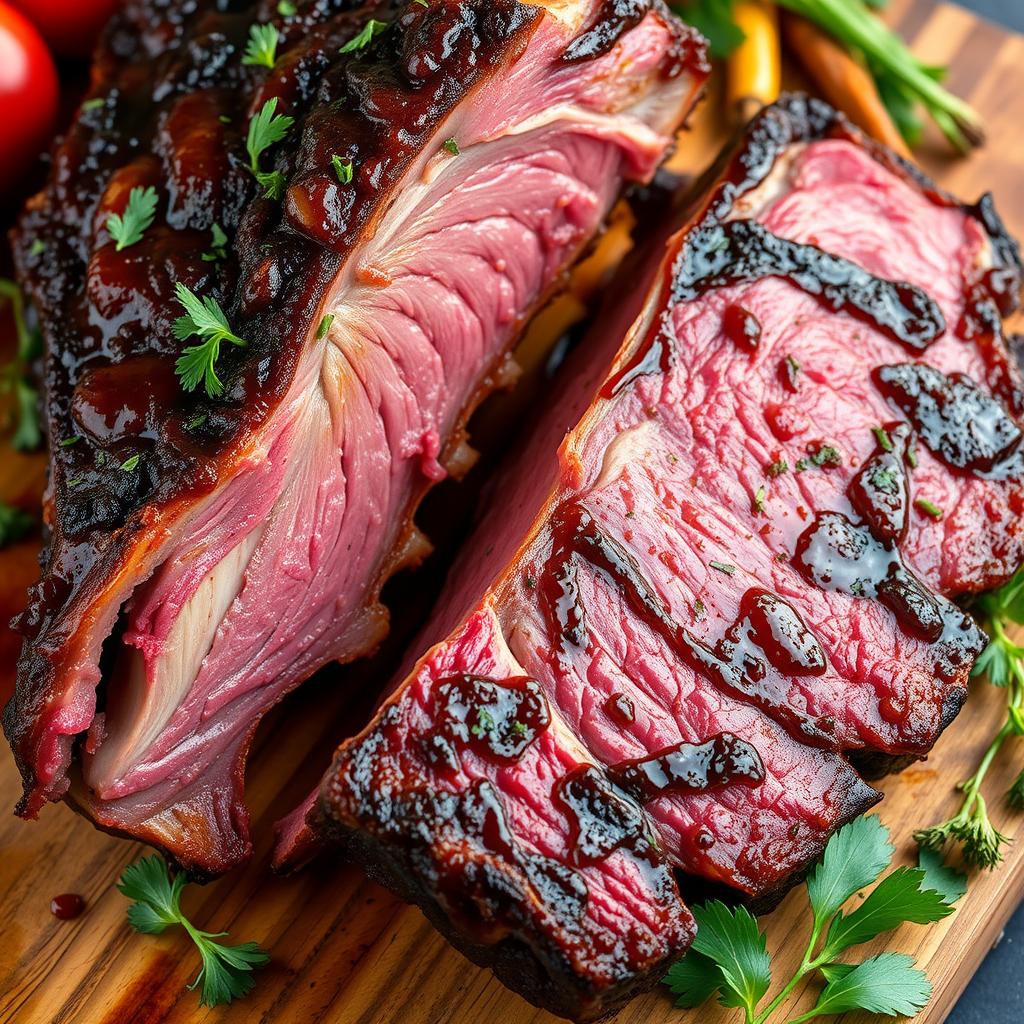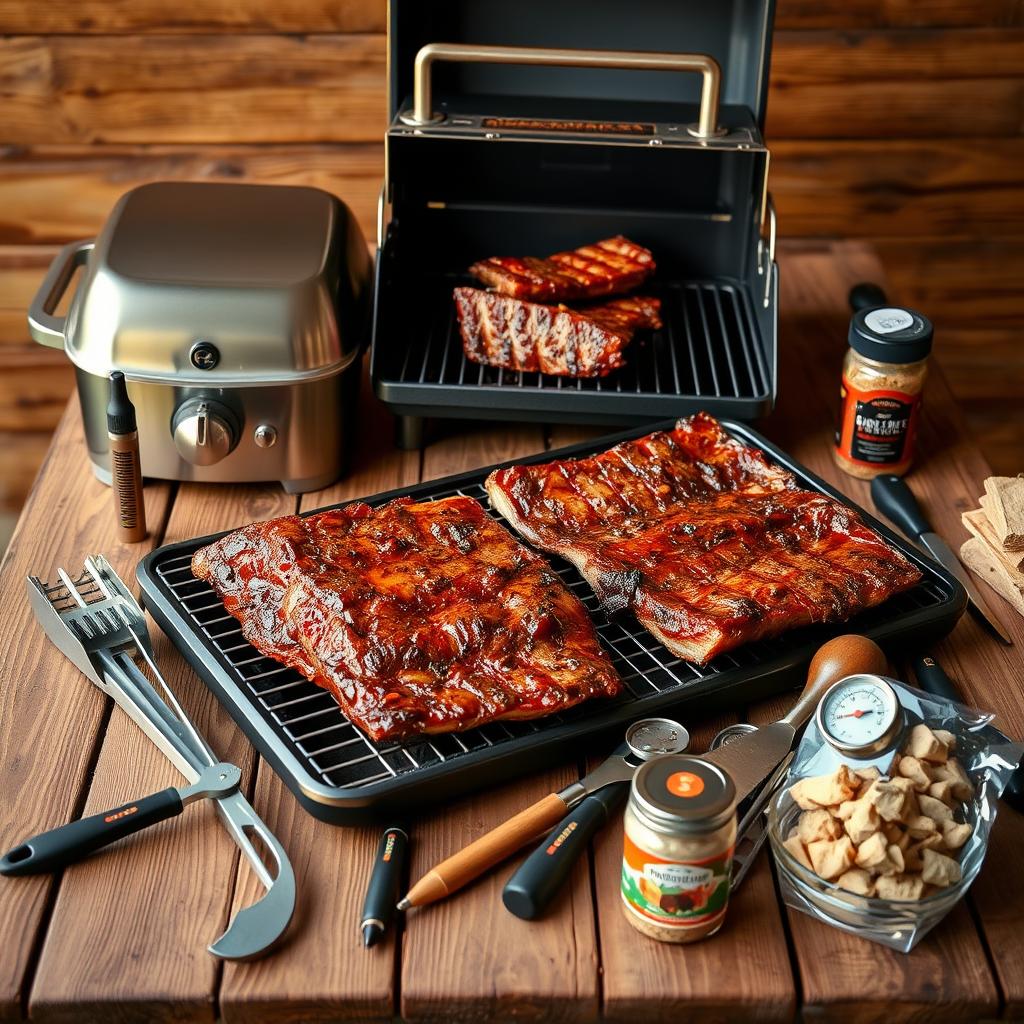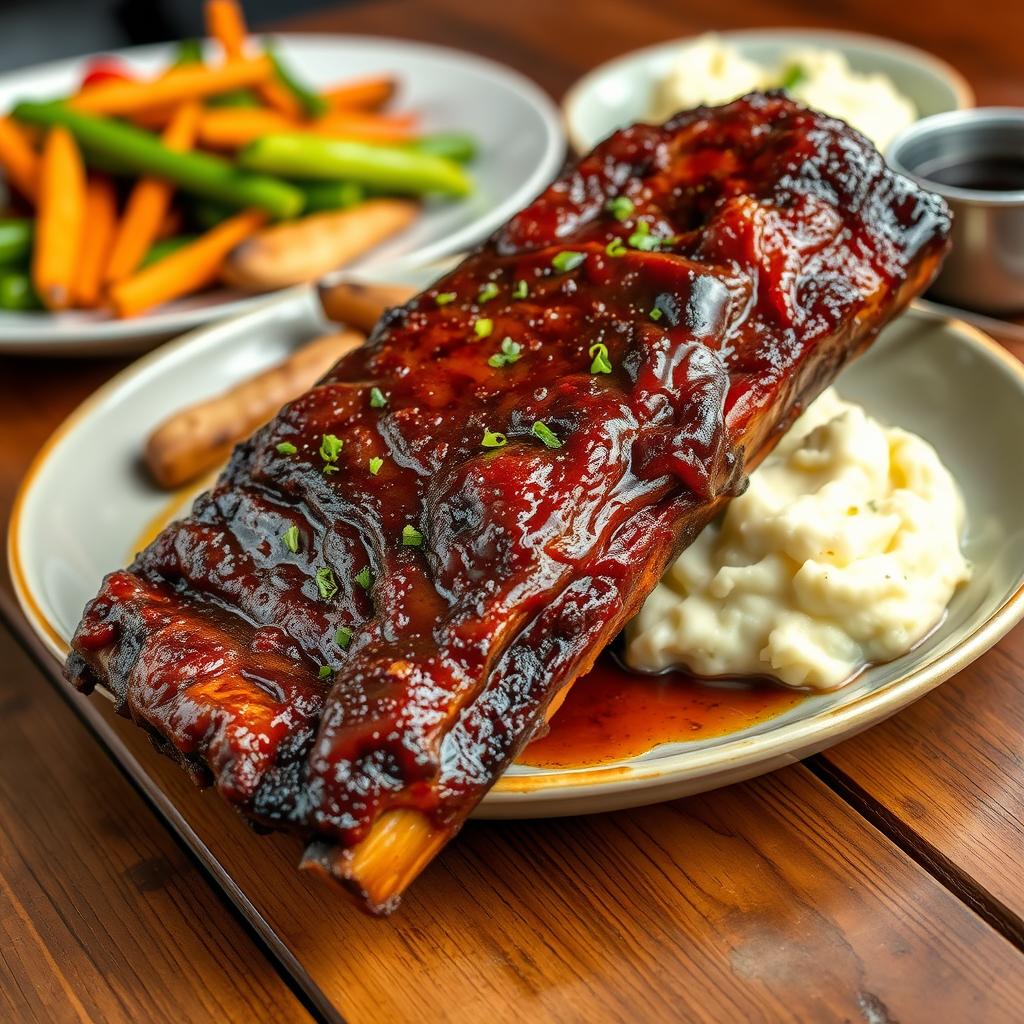Want to make beef back ribs that taste like they came from a restaurant? You’re in the right place. This easy guide will boost your cooking skills. You’ll learn how to make tender beef ribs that will wow everyone.
It’s easy to make juicy beef ribs without being a pro chef. Just use the right methods and ingredients. This recipe is perfect for anyone who loves to cook at home. It will make you feel like a pro, whether you’re grilling on the weekends or cooking for family.
Key Takeaways
- Master a simple yet delicious beef back ribs recipe
- Learn professional-level cooking techniques
- Achieve tender and juicy beef ribs every time
- Impress guests with restaurant-quality results
- Discover easy-to-follow cooking methods
Understanding Beef Back Ribs: A Cut Above the Rest
Exploring beef ribs is a journey of taste and texture. Beef back ribs are a top choice for meat lovers. They offer a mix of tenderness and flavor that’s hard to find elsewhere.

For anyone cooking at home or loving BBQ, knowing about beef back ribs is key. These ribs come from the top of the rib cage, near the spine. This makes them special to meat enthusiasts.
Differences Between Back Ribs and Short Ribs
Beef back ribs and short ribs differ in several ways:
- Location on the cow: Back ribs are from the upper rib cage
- Meat content: Back ribs have less meat than short ribs
- Texture: Back ribs are tender and great for slow cooking
- Flavor profile: Back ribs have a milder meat taste
Quality Indicators When Selecting Ribs
Choosing quality beef ribs is important. Look for these signs:
- Consistent meat color (bright red to deep pink)
- Minimal surface fat
- Smooth, uniform texture
- Fresh appearance without discoloration
Meat-to-Bone Ratio Explained
The meat-to-bone ratio affects your meal. Quality beef back ribs should have a good meat-to-bone balance. Look for ribs with about 1/2 to 3/4 inch of meat covering the bones for the best taste and texture.
“The secret to great ribs is understanding the cut and selecting the highest quality meat possible.” – BBQ Experts
Essential Equipment for Perfect Beef Back Ribs
Getting delicious beef back ribs is more than just good meat and spices. You need the right cooking gear and barbecue tools. Top grill masters say quality tools make a big difference in your cooking.

- Grilling and Smoking Equipment
- Offset smoker
- Pellet grill
- Charcoal grill with adjustable vents
- Temperature Measurement Tools
- Digital instant-read thermometer
- Wireless meat probe
- Infrared surface temperature gun
- Preparation and Handling Tools
- Heavy-duty tongs
- Meat cutting board
- Sharp boning knife
- Aluminum foil
- Spray bottle for moisture
Quality beef rib cooking equipment doesn’t have to be expensive. Start with the basics and add more as you get better.
“The right tools make the chef, not the other way around.” – Professional BBQ Expert
| Equipment Category | Recommended Tool | Price Range |
|---|---|---|
| Smoker | Weber Smokey Mountain | $300-$500 |
| Thermometer | ThermoPro TP20 | $50-$100 |
| Knife Set | Victorinox Fibrox Pro | $100-$150 |
Remember, good barbecue tools are an investment. They help you make amazing beef back ribs that will wow your loved ones.
The Ultimate Beef Back Ribs Recipe
Want a delicious beef back ribs recipe to wow your family and friends? You’re in the right spot. Cooking beef ribs at home might seem tough, but with the right steps, you’ll make a dish that’s restaurant-quality.
Preparation Time and Serving
Prepare for a cooking journey that takes about 4-5 hours. This recipe makes 4-6 servings, ideal for parties or family meals.
Required Ingredients
- 4-5 pounds beef back ribs
- 2 tablespoons olive oil
- 1/4 cup dry rub seasoning
- 1 cup BBQ sauce
- Salt and pepper to taste
Step-by-Step Cooking Instructions
- Remove membrane from rib back
- Pat ribs dry with paper towels
- Apply olive oil and dry rub generously
- Preheat oven to 275°F
- Wrap ribs in aluminum foil
- Bake for 3 hours
- Unwrap and brush with BBQ sauce
- Increase temperature to 350°F
- Bake for additional 30 minutes
- Let rest for 10-15 minutes before serving
“The secret to tender beef back ribs is low and slow cooking.” – Professional BBQ Chef
Your beef back ribs recipe is now ready! Serve it hot and enjoy the rich, succulent flavors you’ve made.
Creating the Perfect Beef Rib Rub
Making a great beef rib rub is like creating a work of art. It turns simple meat into a dish that people remember. The right mix of seasonings can make your barbecue stand out.
A good beef rib rub has sweet, savory, and spicy parts. Here are the basics:
- Coarse kosher salt
- Freshly ground black pepper
- Brown sugar
- Paprika
- Garlic powder
- Onion powder
Experts say the secret is in the mix. Make sure it’s balanced so it brings out the meat’s flavor without overpowering it.
“A great beef rib rub should whisper, not shout.” – BBQ Expert
Here are some tips from the pros:
- Choose fresh, quality spices
- Blend them well
- Spread it evenly
- Let it sit for 30 minutes before cooking
Try adding cayenne for spice or smoked paprika for smokiness. Your special beef rib rub will wow everyone at your next barbecue.
Mastering the Beef Rib Marinade
Turning ordinary beef ribs into a masterpiece starts with marinating. A great marinade can make your meat unforgettable. It adds deep flavors and tenderizes the meat for a memorable meal.
Marinating beef ribs is more than just cooking. It’s a way to transform flavors. Here, we’ll share secrets for a marinade that makes ribs burst with taste.
Essential Marinade Ingredients
A top-notch beef rib marinade needs:
- Acidic base (vinegar or citrus juice)
- Oil for moisture retention
- Herb and spice blend
- Aromatics like garlic and onion
Proper Marinating Techniques
Marinating beef ribs right is key. Use a non-reactive container like glass or food-grade plastic. This prevents flavor loss from chemical reactions.
“The key to a perfect marinade is balance and patience.” – Professional BBQ Chef
Timing and Temperature Guidelines
| Rib Type | Minimum Marinating Time | Maximum Marinating Time |
|---|---|---|
| Beef Back Ribs | 4 hours | 24 hours |
| Refrigeration Temperature | 40°F | Below 40°F |
Don’t over-marinate, as it can make meat tough. Follow the recommended times and keep your ribs cold during marinating.
Slow-Cooking Methods for Tender Results
Turning tough beef back ribs into tender ones takes time and the right slow-cooking method. This way, you get amazing flavor and texture that will make your meal unforgettable.
There are several ways to make slow-cooked beef ribs tender:
- Oven Braising: Low temperature, covered cooking
- Slow Cooker: Consistent, gentle heat
- Dutch Oven Method: Even heat distribution
To get tender beef ribs, cook at low temperatures of 225-250°F for a long time. This slow cooking breaks down collagen into rich, gelatin-like moisture.
“Patience is the secret ingredient in creating perfectly tender beef ribs.” – Professional BBQ Chef
Cooking time varies from 3-6 hours, depending on the method and rib thickness. Make sure to check the meat’s internal temperature for the best tenderness.
| Cooking Method | Temperature | Estimated Time |
|---|---|---|
| Oven Braising | 250°F | 4-5 hours |
| Slow Cooker | 225°F | 6-7 hours |
| Dutch Oven | 275°F | 3-4 hours |
Pro tip: Always use a meat thermometer to check that your beef ribs reach an internal temperature of 195-203°F for maximum tenderness.
Smoking Techniques for Rich Flavor
To turn smoked beef ribs into a masterpiece, you need to master certain techniques. Smoking beef ribs is more than just cooking. It’s about adding layers of flavor that make everyone want more.
Getting great at smoking beef ribs means focusing on three key areas: wood, temperature, and time. Each one is important for that deep, smoky taste we all love.
Wood Selection Guide
Choosing the right wood can make your smoked beef ribs amazing. Different woods give different flavors:
- Hickory: Strong, bacon-like flavor perfect for beef
- Oak: Mild and versatile wood that provides consistent smokiness
- Mesquite: Intense flavor ideal for bold meat lovers
- Apple: Subtle, sweet undertones that complement beef beautifully
Temperature Control Tips
Keeping the temperature steady is crucial for tender, juicy ribs. Aim for 225-250°F. Use a meat thermometer to check the meat’s internal temperature and avoid overcooking.
| Temperature Range | Smoking Result |
|---|---|
| 225-250°F | Perfect tender texture |
| Below 225°F | Slow cooking, potential dryness |
| Above 275°F | Risk of tough, dry meat |
Smoking Duration Guidelines
Smoking beef ribs takes time. Expect 5-6 hours for a full rack. Check tenderness with a probe – it should slide in smoothly. For more ideas, check out this smoky meatloaf recipe.
Pro tip: Wrap your ribs in butcher paper during the final stages to retain moisture and enhance flavor.
Grilling vs. Oven-Baking: Comparing Methods
Choosing between grilled beef back ribs and oven-baked beef ribs changes your cooking experience. Each method has its own benefits, fitting different cooking styles and tastes.
Grilling: The Outdoor Flavor Experience
Grilled beef back ribs have a smoky taste that many love. The heat from the flames makes the outside crispy and keeps the inside juicy. Grilling lets you:
- Achieve beautiful char marks
- Develop deep, complex flavor profiles
- Control heat zones for perfect cooking
Oven-Baked: Consistency and Convenience
Oven-baked beef ribs cook evenly and keep moisture in. This method is great because it:
- Provides consistent temperature
- Requires less monitoring
- Is perfect for cooking all year
“The best cooking method depends on your personal preference and available equipment.” – BBQ Experts
To get restaurant-quality ribs, try a mix of methods. Bake them first to make the meat tender. Then, grill them for a caramelized outside.
Choosing Your Ideal Method
| Grilling | Oven-Baking |
|---|---|
| Smoky flavor | Consistent heat |
| Outdoor cooking | Indoor convenience |
| Direct flame | Even distribution |
Try both grilled and oven-baked beef back ribs to find your favorite way to cook. Each method can make delicious ribs if you pay attention to the details.
Creating the Perfect Glaze and Sauce
To take your beef back ribs to the next level, you need the perfect glaze and sauce. The right sauce can turn simple meat into a feast for the taste buds. It adds flavors that match the smoky taste of the ribs.
A great glaze should mix sweetness, tanginess, and a hint of heat. This mix brings out the meat’s natural flavors. Knowing what makes a sauce stand out is key to a great barbecue.
Classic BBQ Glaze Recipe
Making a classic barbecue sauce for ribs is all about the right mix. Here’s a recipe that will make your ribs shine:
- 1/2 cup ketchup
- 1/4 cup brown sugar
- 2 tablespoons apple cider vinegar
- 1 tablespoon Worcestershire sauce
- 1 teaspoon garlic powder
- 1/2 teaspoon smoked paprika
Alternative Sauce Options
While the classic BBQ glaze is loved by many, trying new sauces can add excitement to your ribs.
| Sauce Type | Key Ingredients | Flavor Profile |
|---|---|---|
| Korean-Inspired Glaze | Gochujang, honey, soy sauce | Sweet and spicy |
| Bourbon Maple Sauce | Bourbon, maple syrup, mustard | Rich and smoky |
| Carolina Mustard Sauce | Yellow mustard, vinegar, brown sugar | Tangy and sharp |
“The secret to an amazing beef rib is not just in the meat, but in the glaze that brings it to life.” – BBQ Master Chef
Try out different glaze recipes to find your favorite. The key is balancing flavors and understanding how each ingredient interacts with the meat’s natural taste.
Tips for Restaurant-Quality Tenderness
To make ribs as tender as those in restaurants, you need more than basic cooking skills. Professional chefs have secrets for making beef ribs that are incredibly tender. Learning these techniques can take your home cooking to the next level.
“The difference between good and great ribs is in the details.” – Professional BBQ Chef
Here are expert tips for making tender beef ribs:
- Use low and slow cooking methods to break down tough connective tissues
- Select high-quality meat with good marbling
- Allow meat to rest at room temperature before cooking
- Wrap ribs in foil during part of the cooking process
The secret to tender ribs is precise temperature control. Professional kitchens use special techniques to ensure tenderness:
- Maintain a steady low temperature between 225-250°F
- Cook ribs for extended periods (typically 4-6 hours)
- Use moisture-retention techniques
Professional chefs suggest using indirect heat to keep the meat moist. This method ensures even cooking and keeps the ribs juicy. A reliable meat thermometer is essential for tracking internal temperatures.
Pro tip: The magic happens when internal meat temperature reaches 195-203°F.
Try different cooking methods like smoking, braising, or slow roasting. Find the method that works best for you to create tender beef ribs that are as good as any restaurant’s.
Common Mistakes to Avoid
Preparing beef back ribs can be tricky, even for experienced cooks. Knowing these common mistakes helps you make tender and delicious ribs every time.
Temperature Control Errors
One big mistake is not controlling the temperature right. Cooking ribs too hot makes them tough and dry. You should cook them low and slow to get that soft, tender texture.
- Avoid direct high-heat grilling
- Maintain consistent low temperatures (225-250°F)
- Use a reliable meat thermometer
Seasoning Pitfalls
Seasoning is key to great beef back ribs. The wrong seasoning techniques can make your meat taste bland or too salty.
| Seasoning Mistake | Solution |
|---|---|
| Under-seasoning | Use a generous, balanced rub |
| Over-salting | Measure seasonings carefully |
Timing Issues
Timing is very important when cooking ribs. Cooking them too long or too short can ruin the dish. Patience is key when making beef back ribs.
“Perfection takes time. Rush your ribs, and you’ll regret it.” – BBQ Pitmaster
Avoiding these common mistakes will improve your rib cooking. You’ll impress your guests with amazing results.
Conclusion
Making the perfect beef back ribs recipe takes passion, practice, and precision. Your journey starts with learning the special techniques that turn regular meat into a memorable meal. You’ve picked up key skills to improve your rib cooking.
The art of making perfect beef ribs is more than just cooking. It’s about controlling temperatures, choosing the best ingredients, and creating your own flavors. By using the tips from this guide, you can make ribs that taste like they’re from a restaurant. For more recipe ideas, check out this link.
Don’t hesitate to try new things and make each recipe your own. Every top chef began with basic skills and then added their own twist. Remember, patience, practice, and focus are key to becoming a rib-cooking pro. Enjoy the process, relish the journey, and delight in the tasty outcomes of your cooking.
FAQ
What are beef back ribs good for?
Beef back ribs are great for barbecues, grilling, and slow-cooking. They’re perfect for tender, flavorful meals. These ribs are ideal for gatherings, family dinners, or special occasions.
They’re especially good for smoking, braising, or oven-roasting. This way, you get maximum tenderness and rich flavor.
Are beef back ribs the same as beef short ribs?
No, beef back ribs and beef short ribs are different cuts. Back ribs come from the top of the rib cage near the spine. Short ribs are cut from the lower portion of the ribs.
Back ribs have less meat and are leaner. Short ribs are meatier and have more marbling.
What is the secret to tender ribs?
The secret to tender ribs is low and slow cooking. Cook the ribs at a low temperature for a long time. This breaks down connective tissues and collagen.
Using a marinade, applying a flavorful rub, and ensuring proper moisture are also key. These steps help achieve fall-off-the-bone tenderness.
Are ribs better in the oven or on the grill?
Both methods have their advantages. Oven-baking provides consistent heat and even cooking. Grilling adds a smoky flavor and beautiful char marks.
Many BBQ enthusiasts prefer a combination method. Start in the oven to tenderize, then finish on the grill for a crispy exterior and smoky flavor.
How do restaurants make ribs so tender?
Restaurants use professional techniques like pre-cooking and extended marinating. They also control temperature precisely. This ensures tender ribs.
They often par-boil or slow-cook ribs before finishing on a high-heat grill. Professional chefs use commercial-grade marinades and smokers. They also have extensive experience in controlling cooking times and temperatures.
What’s the best cooking method for beef back ribs?
Smoking is often the best method for beef back ribs. It cooks the ribs slowly, infusing them with smoky flavor. If you don’t have a smoker, a low-temperature oven with a final grill finish can also produce delicious results.
How long should I cook beef back ribs?
Beef back ribs need 3-5 hours of cooking at a low temperature (around 225-250°F). The exact time depends on the size of the ribs and your cooking method. Slow cooking breaks down connective tissues, making the meat tender and juicy.
Do I need to remove the membrane from beef back ribs?
Yes, removing the membrane is recommended. The tough membrane on the back of the ribs can prevent seasonings from penetrating. It also makes the ribs less tender.
Use a knife to lift a corner of the membrane, then pull it off using a paper towel for a better grip. This step ensures more flavorful and tender ribs.

